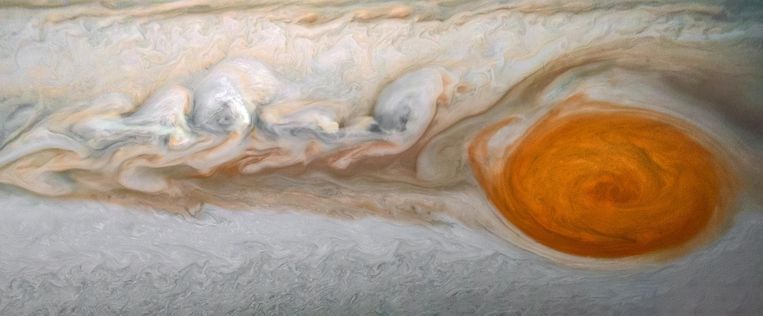
The famous mega storm on Jupiter turned out to be as flat as an atmospheric pie
With a width of about 16 thousand kilometers, it is large enough to swallow the earth in one bite. The winds are blowing at an approximate speed of 430 kilometers per hour – twice as strong as the most powerful hurricane ever wreaking havoc on Earth. And yes: it may have been raging for at least three and a half centuries. The Great Red Spot, the most striking part of the gas giant Jupiter, is arguably the largest storm in the solar system.
This alone makes it scientifically interesting as well. It is therefore not surprising that the unmanned search probe Juno, which has been orbiting the gas giant since 2016, has subjected the giant storm to a detailed analysis. in trade magazine Science Two articles were published Thursday evening summarizing the findings. The most striking result is that the massive storm was completely flat.
Not that it’s thin: the storm hits about 200 to 500 kilometers into Jupiter’s atmosphere, the researchers calculate. But compared to its presentation, this is noticeably understated. This means the slick is relatively much thinner than terrestrial hurricanes, for example, roughly comparable to a homemade pie.
However, the storm affects its surroundings much more deeply in the atmosphere. Research has already shown that the air currents circulating in the vicinity of the storm reach a depth of 3 thousand kilometers.

gravity
According to astronomer Ignas Snellen of Leiden University, it’s not the calculated thickness that catches the eye, but the way the researchers determined it. “I love the way they handled this,” he says. The researchers calculated the thickness of the storm using the gravity that Jupiter exerts on the Juno probe.
To determine the orbits of probes around planets, scientists usually consider the planet as one whole: a kind of solid sphere without any differences. The greater the weight of the planet, the greater the tension of the probe by its gravity. But in practice, this tensile force varies with the distribution of mass under the probe. This difference is reflected in the speed changes of the ship itself. “They were able to measure this so precisely in Juno that they were able to extract the thickness of the storm from the change in the probe’s velocity,” says Snellen. “This is impressive.”
distant worlds
in a second article The researchers described the structure of multiple vortices in Jupiter’s atmosphere, including the Great Red Spot. This allowed them, among other things, to determine the distribution of carbon and oxygen in the atmosphere of Jupiter. This is usually difficult because oxygen atoms – as part of water molecules – are hidden deep in Jupiter’s atmosphere. Thanks to the vortices, which sink under the cloud layer with water vapor, they are still visible.
“I mainly do research on exoplanets, planets that orbit stars other than the Sun,” Snellen says. “The oxygen-to-carbon ratio is a measure of how much a planet has outlived a young star,” he says. “If we knew better about Jupiter, our knowledge of the outermost worlds would also improve.”

“Travel enthusiast. Alcohol lover. Friendly entrepreneur. Coffeeaholic. Award-winning writer.”
